Security System DVR and NVR Comparison
Page Content Links-
Introduction to Video Recorders
What is a DVR?
What is a NVR?
How are DVRs and NVRs Different?
Security Recorders Recap
How Security Cameras are Recorded
Introduction
Welcome to this comparison of DVRs and NVRs. The goal of the page is to serve as a guide on the difference between DVR vs NVR components. It should be noted these components are not the satellite television type even thou the name is the same. Both serve the same purpose…to record video, but ‘what’ they record and ‘how’ is completely unique. The digital recorders discussed here are for security camera systems for homes and small businesses. They can be found as a standalone unit as this gives the user choices over camera types and sensor configurations. They can also be purchased as a packaged deal in a complete home security system. These are different is functionality in that they are designed to accept input signals from CCTV and IP cameras, and not antennas or cable TV signals.
Home video recording started with analog magnetic tape technology. The tape recorder(audio) and the VCR(Video Cassette Recorder (audio and video)) come to mind. Long spools of plastic media tape contained in plastic casings were in every home and every electronics store across America. Times have changed big time.
We now have ‘digital’ recording techniques. No more stings of tape and low quality resolution. Precise digital reproduction of the original content can be infinity achieved. DVDs (Digital Video Discs) paved the way to easy high quality resolutions for home playback and is still widely in use as of 2017. The flip side is the DVD recorder. This little gem gave people the freedom to ‘record’ their own HD digital content. We are now close enough on the timeline of progress to cover DVRs and NVRs, the next incarnation of digital recording at home.
Digital Recorders exclusive for video formats have been in production since around 1999. They were mainly designed for recording TV shows and movies onto a built in HDD or hard disk drive. The general size used in home security systems is the SATA 3.5 inch internal drive which is made by many different manufacturers.
The medium recorded was still analog and the formats of PAL(Phase Alternating Lines) and NTSC(National Television System Committee) were typical in North America. Once the recording technology had settled into the home entertainment industry, the security market took notice of the new vehicle for recording video and the multi-channel DVR was quickly born.
What Format is a Recorded Video?
Whether you are recording analog or digital sources, the data stored on a DVR unit was converted from its original signal to a compressed file. Both video and audio are generally compressed and they get there own separate format. MPEG-2 is a standard video file type and is a well established encoding and can be read and displayed by many of today’s devices. Another popular storage saving choice, the H.26X family of conversions. This includes H.261, H.262, H.263, H.264, and H.265. Each has its unique characteristics. H.264/AVC is most widely used as the standard for encoding video. This actually is an improvement from MPEG conversions as it has a lower bit rate while still allowing resolutions up to 4K UHD. A side note is this compression is what today’s Blu-ray discs use. Compression methods are often applied prior to recording onto the hard drive as this save space and time is reduced to transfer the data. Audio is separately handled and converted to a MP3 format and stored along with its video data for playback.
“Record Rate” is another specification to DVR and NVR recording. This means the recorded frame rate for that particular resolution and is designated as ‘fps‘. They each have their own predetermined range or set value. Rates change as the resolution changes and they can be as low as 30 and as high as 120 per second. Consult the user manual for the accurate rate for a certain model of DVR. The higher the rate the smoother the motion and video capture. Still frames are now multiplied and the object won’t skip and jump a great distance across the screen as it would with less frames in the timeline. But this also means more data per second too. Its a bit of a trade off. Better recorded resolution and less overall capacity on the hard drive, or lower resolution and more storage capacity. Technology will improve hard drives and bandwidth requirements so it becomes easier to manage year after year.
Digital video recorders give the user great time line transfer control as well. Rewinding, pausing and forward controls of the live video stream are now possible. Timeline shifting and event declarations are functions not possible with past analog tape recorders. They can support protocols of TCP/IP, UDP, DNS/DDNS. SMTP, UPNP, DHCP, HTTP and other server related definitions of compilation.
Where do these formats come from? The group associated with all this technical sorting is the the Video Coding Experts Group(VCEG). They along with many other professional and technical groups
Security DVRs Use ‘Channels’
Nearly all modern security system based DVRs and NVRs allocate inputs into channels. Channels are individual signal paths and controls for a single input. The input of a channel is a single camera’s output signal. Channels can be customized and named within most interface setting menus. At times security systems use more than one camera in the system. This is where channels help distinguish one camera signal from another. Two channel, 4 channel, 8, 16, 32, even the mega large 64 channel systems are in use today.
Font Panels
The Front Panels found on the many DVRs and NVRs are comprised of similar features. The manufacturers spend large budgets on field testing and designs to make their devices as practical and interesting as possible without giving option paralysis. The 4 way keypad or compass style keypad is very common on DVRs and NVRs for it ease of use in navigation with the confirm button typically directly in the middle of the arrangement. Status lights give instant feedback showing active modes and settings. Some of the more common functions will have buttons such as record mode, alerts, and power on/off. Although many of today’s styles are leaving moving parts behind and eliminating front buttons to the bare minimum. This leaves the front panel sleek and futuristic.
the confirm button typically directly in the middle of the arrangement. Status lights give instant feedback showing active modes and settings. Some of the more common functions will have buttons such as record mode, alerts, and power on/off. Although many of today’s styles are leaving moving parts behind and eliminating front buttons to the bare minimum. This leaves the front panel sleek and futuristic.
Rear Panels
Rear Panels are where the action connects. Typical hardware is found on most units. Industry standard connectors are used for a greater working electronics community.

Rear panels are where all the connectivity happens. Each channel has a dedicated BNC or RJ45 10 / 100M self adaptive ports for PoE systems. PoE stands for “Power Over Ethernet” where 12VDC power is conducted along the same cable as the video signal. Audio connection in the form of terminals or RCA jacks are common. This typically requires powered mics and speakers at the points of communication. USB ports are present for the mouse during on screen use. Power port and ON/OFF switch are the other naturally accruing features of a rear panel.

What is a DVR?

DVR stands for “Digital Video Recorder”. They are considered “centralized” components. A security system incorporates the DVR as the central hub for all the inputs from peripherals and outputs for the display and audio. The entire system is directly connected to the DVR. Inputs from cameras are connected via BNC cabling and are generally not wireless. All signal processing and compression encoding is done within the DVR itself.
DVR Storage Mediums
One way DVRs record video is with a Sata Hard Disk Drive. The drive will either be installed directly into the chassis of the unit, or it will be external and connected with a USB cable. The drives in today’s DVRs start in size around 500GB(gigabyte) and can be increased up to 6TB.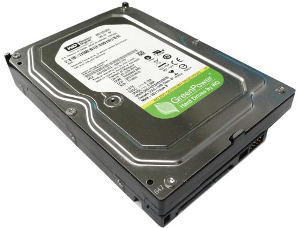 In the quest for more storage, some DVR have two docks for two HDD drives at the same time. A second way DVRs store file data is with a USB Thumb Drive. This allows for events or footage you have interest in be transported easily without the whole chassis coming along too.
In the quest for more storage, some DVR have two docks for two HDD drives at the same time. A second way DVRs store file data is with a USB Thumb Drive. This allows for events or footage you have interest in be transported easily without the whole chassis coming along too.
DVR Resolutions
A security camera systems has a predetermined set resolutions it can processes footage to record and playback. The cameras have a specific resolution they capture imagery. The DVR has to be able to record up to the cameras resolution, and it needs to have playback mode for that recorded resolution too.
The top of the line today is the UHD 4K resolution followed closely by HD resolutions of 1080p and 720p. With features such as zoom and still capture, having these high resolutions is a joy. Fine details are no problem when cropping or zooming in on a face or license plate. Other popular resolutions on the market include TVL resolutions. TVL stands for “television lines”. These are analog resolutions and many DVRs can decode and display them natively.
What is a NVR?
NVR stands for “Network Video Recorder”. These systems are “decentralized”. NVRs are not the central hub of processing, but merely the recording device and interface for editing recorded video. They connect to either a network connection routing the cameras to the NVR or the easiest option is the PoE connection which supplies power to the cameras and conducts the signal back to the NVR also. 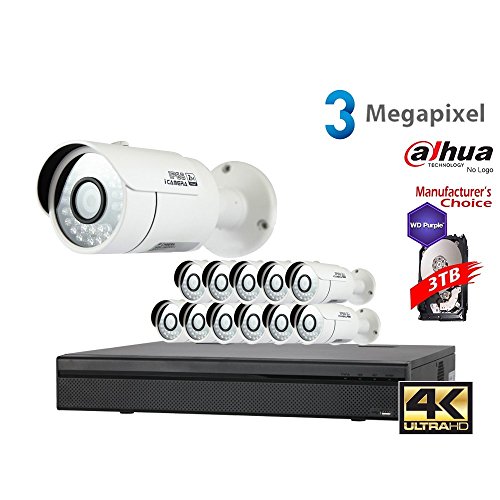 The cameras are IP type cameras and many come WiFi ready so routing cables in not necessary. This sounds complicated but its a simple plug and play procedure. The NVR finds this feed on the network and all the other camera feeds on the network and saves them onto the allocated drive.
The cameras are IP type cameras and many come WiFi ready so routing cables in not necessary. This sounds complicated but its a simple plug and play procedure. The NVR finds this feed on the network and all the other camera feeds on the network and saves them onto the allocated drive.
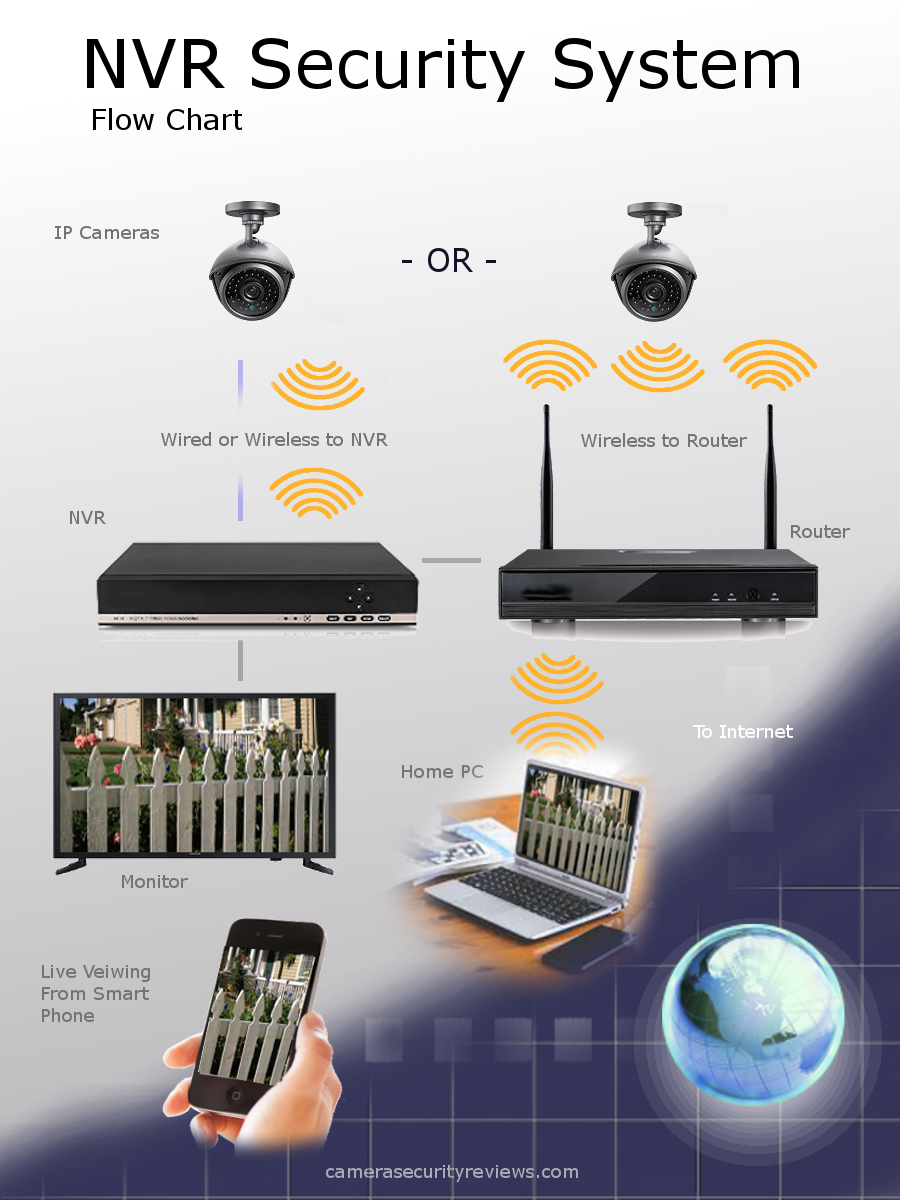
NVR Storage Mediums
NVRs record video on the either a built in hard drive or external drive. The external drive may be a USB drive or some even offer SD slots. 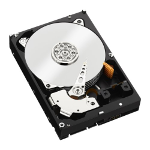 Hard drives in today’s NVRs range from about 500GB to an optional 6TB of space. Just like a few DVR’s, an NVR can have two or more HDD drives at the same time. The Western Digital Caviar Green, even with its funny name is highly recommended and built for DVR and NVR use.
Hard drives in today’s NVRs range from about 500GB to an optional 6TB of space. Just like a few DVR’s, an NVR can have two or more HDD drives at the same time. The Western Digital Caviar Green, even with its funny name is highly recommended and built for DVR and NVR use.
NVR Resolutions
Resolutions are the industry standards such as 720P, 1080P, 1080N, and even now up to 4K Ultra High Definition. Security systems are required to conform to the video standard set by groups like the Advanced Television Systems Committee (ATSC). This ensures code languages stay consistent at a global community level.
Many NVR allow multiple monitors via HDMI, BNC, and VGA ports. Even the basic NVR systems will allow at least a 720p HD resolution with analog 1200TVL compatibility.
What Is The Best NVR For Home Use
NVRs come in a shelf full of flavors. Which NVR is the best for home use and is it the most expensive? The question is one answered differently from those you ask. You need to compile a list of wants and another list of things you are will not give up. Of course the overall budget is third filter keeping your selection size reasonable. The wants will serve as the main guide in selecting features of you are interested in from a NVR and the ‘give up’ list will filter down the systems should there be any similar choices.
Top NVR Features To Look For:
- Wireless Cameras – WiFi cameras remove the need for long Ethernet cables to reach the installed cameras.
- Large HDD – Large hard drives provide plenty of storage when recording large resolutions and frame rates.
- PoE Ready – This is the ability for a single cable to transmit video to the NVR, and receive DC power from the NVR. This is incredibly helpful with multiple channel systems. Wireless cameras don’t need PoE because they don’t need a hard wired Ethernet connection. **When an IP camera is out of range, an Ethernet cable will substitute as the signal transmit medium.
After that research is done read user reviews and see what the real world thinks of your choice. If you want to know right now what consumers say is a good quality product then the best ranked NVR as of late is the Zosi 4 Channel 1080p NVR. 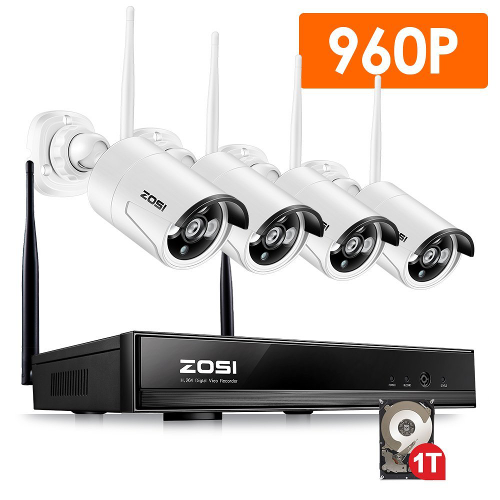 This package comes with 4 x 960P wireless cameras and 1TB storage. Resolutions of 480 up to
This package comes with 4 x 960P wireless cameras and 1TB storage. Resolutions of 480 up to
The Difference Between DVRs vs NVRs
DVR Differences
The main standout separation between DVR and NVR are how they receive the camera signal. The cameras are two different breeds for each of the recorder types. DVR’s like the standard CCTV camera signal which can be a digital HD or analog TVL format. The cameras capture video as a stream of data from the light sensors and the DVR does all the processing and compression before recording to the disk drive.
NVR Differences
True to form, NVR’s incorporate IP cameras for the source of video it records. The IP camera creates an address and connects to the LAN network or directly to the NVR, in which then the NVR would relay the camera feeds to the LAN network. Cameras are ‘paired’ to the NVR similar to a Bluetooth pairing method. NVRs that are part of a complete kit most of the time will come pre-coded to the NVR making initial setup almost as easy as turning on the power.
What Are DVR/NVR Hybrids?
Hybrids run on gas and batteries. Just kidding. I’m seeing if any one is still reading this page. No gas, but two genres of cameras. Hybrids are the magic bridge between the old days and the new. They have the unique ability to accept CCTV analog cameras, and digital HD resolution cameras. Now the magic is the they can also take the output of IP cameras. Three methods for video creation can all be recorded and edited withing the Hybrid DVR/NVR.
DVR/NVR Hybrid 1080N?
The resolution often found in the Hybrid models is the 1080P or 1080N HD . This seems a common choice with today’s monitors being of the wide screen variety.
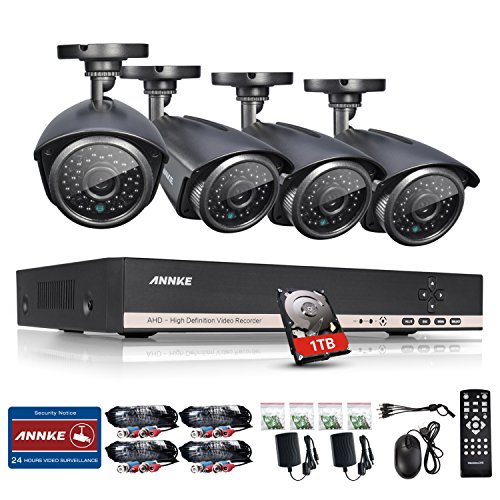
How Are DVRs and NVRs Similar?
Top Similarities Between a DVR vs NVR
- They are both video recording devices designed around channels of inputs and sensor inputs as well
- Both feature PTZ control for Zooming and Motion controls
- They can both incorporate dome and bullet style cameras
- They offer internal and external storage capacity
- Both can display via HDMI, BNC, or VGA to the monitor(s)
- Smart features and timeline navigation controls via GUI(Graphical User Interface)
- Many have 2-Way Audio Intercom Ports
- Sustain an array of cameras from 2 channels up to 64 channel systems
- They both allow expansion drives for increased store space
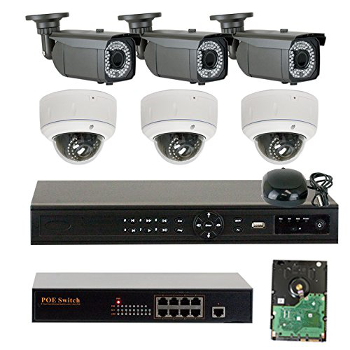
Security Recorders Recap
At The End Of The Day…
At the end of the day, DVR’s are nearly identical to NVR’s. They are both proper recording devices for home and small business security systems and there are more features these two have in common than opposed. Consumers have embraced NVRs as much as DVRs over the last few years. The fact both DVRs and NVRs are a HDD based storage means the live video can be manipulated by pausing, forward, rewind, and large leaps from one point in time to another can be done without long lag times. To access all the great features a DVR or NVR has software included as a graphic user interface. Both recorders can use full HD resolution cameras within the system. And yet another point is they both allow access to live viewing from remote locations or smart phones.
So Why Would You Want A NVR?
Why would someone wanting a home security system choose a NVR based system over a DVR recorder? One word…wireless. Yes when IP cameras are used the option exists to connect via WiFi to get onto the LAN network. This is why NVR’s standout. They can collect signals from the network or directly. DVRs do have live viewing thru apps because they do connect into the LAN network. This means when you’re on an internet browser anywhere you can call that specific web address and ports. NVRs can get a camera’s feed directly via Ethernet cabling or it can go onto the LAN and discover the wireless paired cameras at their respective IP addresses. The software in all these devices make it simple to use and secures the network they reside on.
So do some reaserch into what security systems peak your interest and thanks for reading. Visit our article page for more on Home Secuirty Products.
